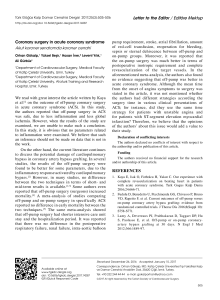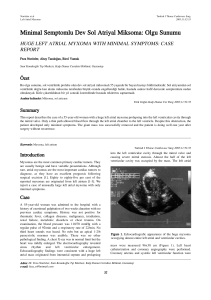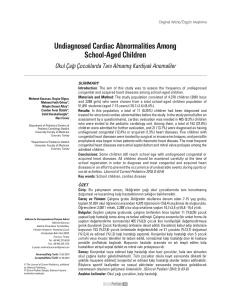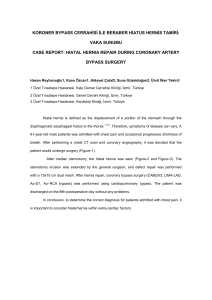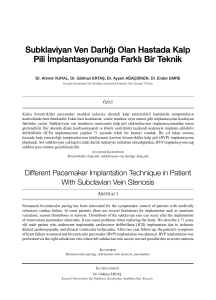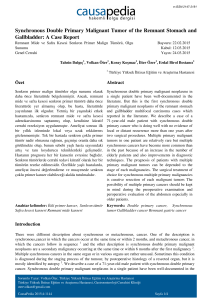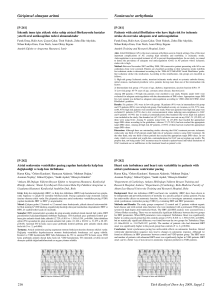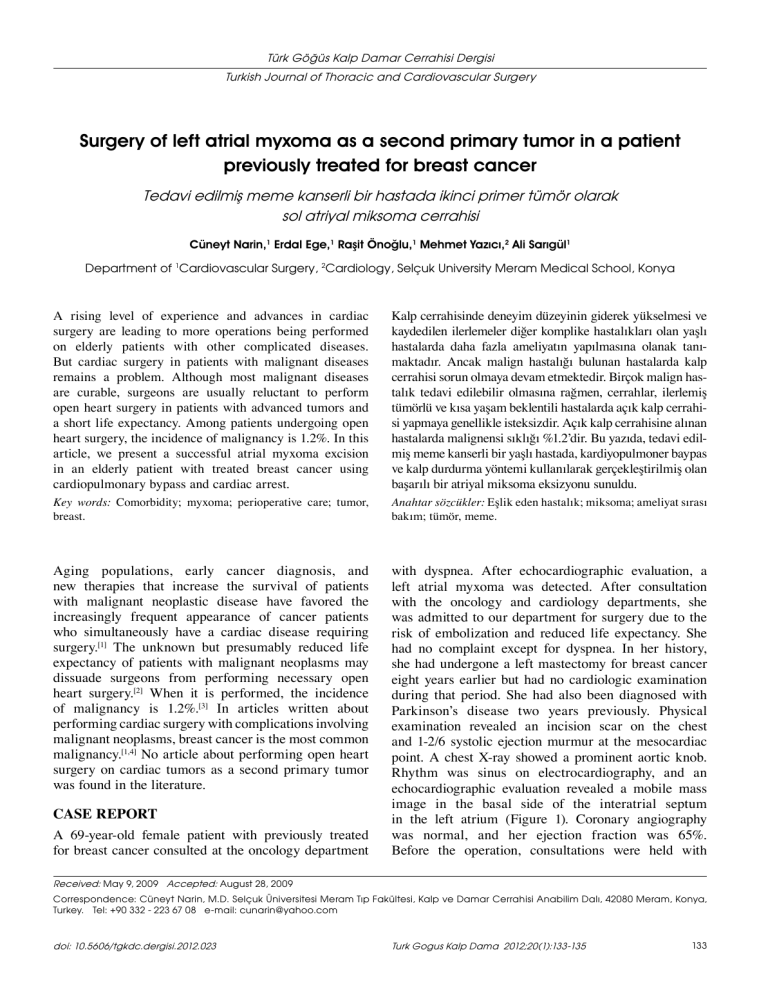
Türk Göğüs Kalp Damar Cerrahisi Dergisi
Turkish Journal of Thoracic and Cardiovascular Surgery
Surgery of left atrial myxoma as a second primary tumor in a patient
previously treated for breast cancer
Tedavi edilmiş meme kanserli bir hastada ikinci primer tümör olarak
sol atriyal miksoma cerrahisi
Cüneyt Narin,1 Erdal Ege,1 Raşit Önoğlu,1 Mehmet Yazıcı,2 Ali Sarıgül1
Department of 1Cardiovascular Surgery, 2Cardiology, Selçuk University Meram Medical School, Konya
A rising level of experience and advances in cardiac
surgery are leading to more operations being performed
on elderly patients with other complicated diseases.
But cardiac surgery in patients with malignant diseases
remains a problem. Although most malignant diseases
are curable, surgeons are usually reluctant to perform
open heart surgery in patients with advanced tumors and
a short life expectancy. Among patients undergoing open
heart surgery, the incidence of malignancy is 1.2%. In this
article, we present a successful atrial myxoma excision
in an elderly patient with treated breast cancer using
cardiopulmonary bypass and cardiac arrest.
Kalp cerrahisinde deneyim düzeyinin giderek yükselmesi ve
kaydedilen ilerlemeler diğer komplike hastalıkları olan yaşlı
hastalarda daha fazla ameliyatın yapılmasına olanak tanımaktadır. Ancak malign hastalığı bulunan hastalarda kalp
cerrahisi sorun olmaya devam etmektedir. Birçok malign hastalık tedavi edilebilir olmasına rağmen, cerrahlar, ilerlemiş
tümörlü ve kısa yaşam beklentili hastalarda açık kalp cerrahisi yapmaya genellikle isteksizdir. Açık kalp cerrahisine alınan
hastalarda malignensi sıklığı %1.2’dir. Bu yazıda, tedavi edilmiş meme kanserli bir yaşlı hastada, kardiyopulmoner baypas
ve kalp durdurma yöntemi kullanılarak gerçekleştirilmiş olan
başarılı bir atriyal miksoma eksizyonu sunuldu.
Key words: Comorbidity; myxoma; perioperative care; tumor,
breast.
Anah­tar söz­cük­ler: Eşlik eden hastalık; miksoma; ameliyat sırası
bakım; tümör, meme.
Aging populations, early cancer diagnosis, and
new therapies that increase the survival of patients
with malignant neoplastic disease have favored the
increasingly frequent appearance of cancer patients
who simultaneously have a cardiac disease requiring
surgery.[1] The unknown but presumably reduced life
expectancy of patients with malignant neoplasms may
dissuade surgeons from performing necessary open
heart surgery.[2] When it is performed, the incidence
of malignancy is 1.2%.[3] In articles written about
performing cardiac surgery with complications involving
malignant neoplasms, breast cancer is the most common
malignancy.[1,4] No article about performing open heart
surgery on cardiac tumors as a second primary tumor
was found in the literature.
with dyspnea. After echocardiographic evaluation, a
left atrial myxoma was detected. After consultation
with the oncology and cardiology departments, she
was admitted to our department for surgery due to the
risk of embolization and reduced life expectancy. She
had no complaint except for dyspnea. In her history,
she had undergone a left mastectomy for breast cancer
eight years earlier but had no cardiologic examination
during that period. She had also been diagnosed with
Parkinson’s disease two years previously. Physical
examination revealed an incision scar on the chest
and 1-2/6 systolic ejection murmur at the mesocardiac
point. A chest X-ray showed a prominent aortic knob.
Rhythm was sinus on electrocardiography, and an
echocardiographic evaluation revealed a mobile mass
image in the basal side of the interatrial septum
in the left atrium (Figure 1). Coronary angiography
was normal, and her ejection fraction was 65%.
Before the operation, consultations were held with
CASE REPORT
A 69-year-old female patient with previously treated
for breast cancer consulted at the oncology department
Received: May 9, 2009 Accepted: August 28, 2009
Correspondence: Cüneyt Narin, M.D. Selçuk Üniversitesi Meram Tıp Fakültesi, Kalp ve Damar Cerrahisi Anabilim Dalı, 42080 Meram, Konya,
Turkey. Tel: +90 332 - 223 67 08 e-mail: cunarin@yahoo.com
doi: 10.5606/tgkdc.dergisi.2012.023
Turk Gogus Kalp Dama 2012;20(1):133-135
133
Turk Gogus Kalp Dama
Figure 1. Echocardiography shows a myxoma in the left atrium which is prone to move toward the
left ventricle.
the oncology, neurology, pulmonary medicine, and
infectious diseases departments. Chemotherapeutic
drugs for breast cancer were used until the day of the
operation with a plan for their continued use in the early
postoperative period. The patient's Parkinson’s disease
presented no inconveniences for the surgery. For the
postoperative period, the infectious diseases department
recommended the use of intravenous cefazolin sodium
as a prophylactic antibiotic as well as the monitoring
of infection markers, such as white blood cells,
sedimentation rate, and C-reactive protein. Surgery was
performed using median sternotomy. After aortic and
bicaval cannulation, cardiopulmonary bypass (CPB) was
established, and aortic cross-clamping was done. Cold
blood cardioplegia was used, and the patient was cooled
down to 32 °C. Left and right atriotomies were carried
out. Myxoma was seen on the part of the interatrial
septum near the mitral valve, and there was an invasion
into the interatrial septum (Figure 2). The myxoma and
invasion site of the atrial septum were excised, and the
atrial defect was closed using primary sutures through
the right atrium. The patient was uneventfully weaned
from CPB and taken to the intensive care unit. She
was extubated on the eighth postoperative hour. On the
first postoperative day, she was mobilized and her chest
tubes were removed. During the postoperative period,
the oncology, neurology, pulmonary medicine, and
infectious diseases departments were again consulted,
and her medical treatment was reorganized. When
control echocardiography was performed, the left
atrium was clear. There was no pathology on the mitral
134
valve, and cardiac functions were normal. The patient
was discharged on the sixth postoperative day without
any complications. On her 12-month follow-up, she
was asymptomatic, and an echocardiography revealed
normal cardiac function.
DISCUSSION
Cardiac surgery in selected patients with previously
treated cancer is safe and offers clinical improvement at
a reasonable operative risk.[2] Carrascal et al.[1] reported
no significant increase in morbidity or mortality from
heart surgery with extracorporeal circulation in cancer
patients. As a specific group, cardiac surgery can be
performed with acceptable mortality, but there are
Figure 2. Intraoperative view of the myxoma of the left atrium.
Narin et al. Myxoma in a patient with breast cancer
significant morbidity rates in patients with hematologic
malignancies.[5] Patients with a malignant tumor which
was treated less than two years previously, advanced
age, pulmonary disease, or impaired left ventricular
function should be made aware of the limited survival
potential. A decision to perform cardiac surgery in
patients with a potentially curable malignant tumor
found coincidentally must be made with care.[4]
In the literature, most open heart surgeries on
patients with malignant tumors are performed for
coronary revascularization and valve replacement.[2,4]
There is also concern about the recurrence of cancer
as a result of impaired immune system function after
CPB.[2] Therefore, off-pump cardiac surgery is both
very effective and greatly advantageous for patients
with a malignancy who require cardiac surgery.[6] Fatal
progression of the tumor is seen if the time interval
between the occurrence of the malignant tumor and
cardiac surgery is short.[4]
Most patients with a malignant neoplastic disease are
prone to infection and bleeding due to the bone marrow’s
suppressive effects of either the malignant disease or
anticancer treatment.[7] In patients undergoing coronary
artery operations after breast cancer, sternal wound
infection and noncardiac chest pain are significantly
higher than in the normal population.[8] Neither of these
were seen in our patient.
Among patients undergoing open heart surgery,
the incidence of patients with malignancy is 1.2%.[3]
In articles about cardiac surgery with complications
involving malignant neoplasms, breast cancer is the
most common malignancy.[1,4]
No link between treated breast cancer and left
atrial myxoma was considered. We believe this state
was merely coincidental in a patient with two primary
tumors.
In conclusion, cardiac surgery in patients with
previously treated cancer remains a challenging problem.
Using less invasive methods, such as off-pump cardiac
surgery, and actively consulting with other related
departments about such patients play an important
role in the surgery's success. Wider-ranging studies are
needed to demonstrate the results of cardiac surgery in
patients with malignant disease.
Declaration of conflicting interests
The authors declared no conflicts of interest with respect
to the authorship and/or publication of this article.
Funding
The authors received no financial support for the
research and/or authorship of this article.
REFERENCES
1. Carrascal Y, Gualis J, Arévalo A, Fulquet E, Flórez S,
Rey J, et al. Cardiac surgery with extracorporeal circulation
in cancer patients: influence on surgical morbidity and
mortality and on survival. Rev Esp Cardiol 2008;61:369-75.
[Abstract]
2. Canver CC, Marrin CA, Plume SK, Nugent WC. Should
a patient with a treated cancer be offered an open heart
operation? Ann Thorac Surg 1993;55:1202-4.
3. Konishi T, Fuse K, Makuuchi H, Watanabe Y, Kaneko T,
Watanabe G, et al. Treatment of cases of cardiac surgery
complicated with malignant neoplasms. Nihon Geka Gakkai
Zasshi 1991;92:351-6. [Abstract]
4. Mistiaen WP, Van Cauwelaert P, Muylaert P, Wuyts F,
Harrisson F, Bortier H. Effect of prior malignancy on survival
after cardiac surgery. Ann Thorac Surg 2004;77:1593-7.
5. Fecher AM, Birdas TJ, Haybron D, Papasavas PK, Evers D,
Caushaj PF. Cardiac operations in patients with hematologic
malignancies. Eur J Cardiothorac Surg 2004;25:537-40.
6. Ochi M, Yamada K, Fujii M, Ohkubo N, Ogasawara H,
Tanaka S. Role of off-pump coronary artery bypass grafting
in patients with malignant neoplastic disease. Jpn Circ J
2000;64:13-7.
7. Nurözler F, Kutlu ST, Kücük G. Off-pump coronary
bypass for patients with concomitant malignancy. Circ J
2006;70:1048-51.
8. Erez E, Eldar S, Sharoni E, Abramov D, Sulkes A, Vidne BA.
Coronary artery operation in patients after breast cancer
therapy. Ann Thorac Surg 1998;66:1312-7.
135

